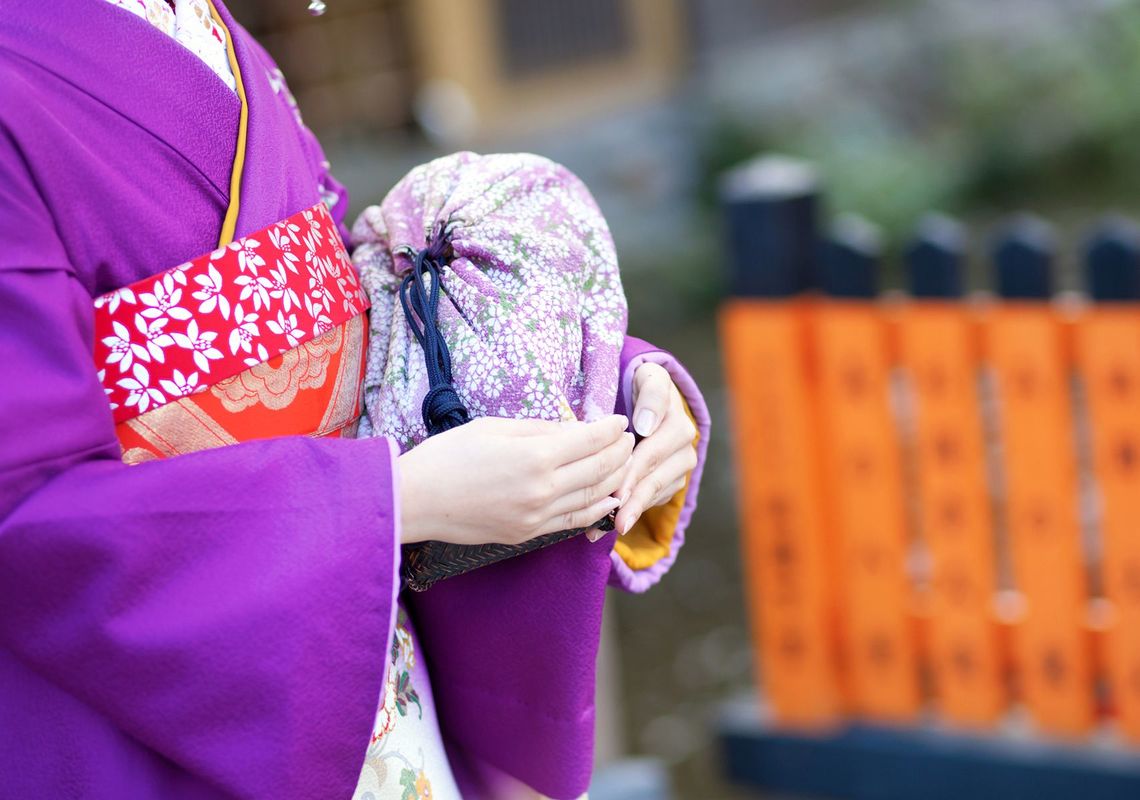
In Japan, the essentials for living are described with three characters: 衣 (i), 食 (shoku), and 住 (ju), which stand for, respectively, clothing, food and shelter. In a new series of articles, we’ll be focusing on these three aspects, looking at them one by one and presenting them especially for readers from abroad who are looking to visit Tokyo.
Let's begin with closing.
The traditional Japanese garment is the kimono, which is associated with a number of little mysteries. Japanese folk may not think the kimono is something mysterious, but they would be surprised to find out the trivia associated with it. Below, we take a look at the mysteries in the form of questions (scroll down to the end of the article for the corresponding explanations).
Mystery 1: How come vintage kimonos are so cheap?
So you want to buy a kimono? While you can find them at department stores and speciality shops (gofuku-ya) in places like Ginza, they’re pretty expensive. You can, however, pick up a secondhand one at a much more affordable price. For instance, a luxurious \1 million kimono, made with gold and silver threads and still looking as good as it did on the day it was first bought, can be bought secondhand for around \50,000.
Why do Japanese women still wear kimono?
Mystery 2: Why isn't samurai attire (men’s kimonos) used for tourism?
If you go to Buckingham Palace or Vatican City, you’ll be sure to find soldiers dressed in colourful traditional garments, providing the perfect setting for a photograph. Yet if you go to the Imperial Palace or the National Diet Building here in Tokyo, you’ll be disappointed to see there are no guards bedecked in samurai attire.
If you want to see traditional samurai kimono as worn by men, you'll have to visit a kabuki theatre, such as the Kabuki-za, Shinbashi’s Enbu-jo, or the National Theatre of Japan. Although you’ll also see actors playing imperial courtiers and Edo townspeople, the majority of the roles involve samurai--an excellent chance for you to see them in full regalia. However, rarely, if ever, do you see men wearing formal kimonos on the streets of Tokyo.
Mystery 3: Why do women still wear kimonos in daily life, unlike men?
If you want to see the female form in kimono, you'll also find this at the theatre. Not only do the actors dress in kimono, but roughly 20 percent of theatregoers attend in traditional garb. Note that patrons tend to wear plain, unadorned kimono, so you won’t see much extravagance there.
Another option is to visit a fine-dining establishment and have a geisha entertain your party. This is expensive, though: discounting the food and drink, having a single geisha serve you and your guests for two hours can cost around \30,000. If the entertainers come in a trio, as in Kyoto with a maiko and geiko, the bill may well come to \100,000 or more. (What’s the reason for these steep prices? That’s a topic for another article!)
For a far more convenient --and free--option, you could spy on a wedding. Whether you’ll be allowed to take photographs and observe the ceremony depends on the hosts, but if you hang out near a hotel reception hall on a spring or autumn afternoon, you'll surely get to see a lovely bride kitted out in full kimono.
Weddings in Japan are often held on specific dates believed to be auspicious. These days, known as taian, usually occur once every six days. Hence, if you play your cards right, you should be able to find a bride at a hotel every six days or so. By ‘or so’ we mean that the date sometimes comes along every five days, instead of the usual six.
Confusing, no? Few Japanese people even know the whys and wherefores behind this calendrical cycle. Although not everyone observes this rule, it’s estimated that less than one percent of Japanese people hold weddings on the butsumetsu, a ‘malevolent day’ that gets its name from the Buddha's death.?
In general, Japanese women wear kimono at four key points in their lives, with the wedding being the last. The first time kimonos are worn is at ages three and seven during the month of November--a time when girls visit shrines with their families to give thanks for being alive and in good health.
The next occasion comes at the age of 20, and is known as the coming-of-age ceremony. The kimono industry’s golden days are long over, so the time before this ceremony is when shops make most of their sales. So, aside from at weddings, you could glimpse female kimono-wearers if you visit a shrine in early November or go to a local ceremonial hall in early January on Coming of Age Day.
THE ANSWERS REVEALED:
Mystery 1: How come vintage kimonos are so cheap?
Nowadays, the kimono is considered formal attire. As such, it’s like a wedding dress, worn only once, or a few times after the coming-of-age ceremony at most. People either buy or rent them. Therefore, a personal kimono worn to a formal event just once may still be, for all intents and purposes, brand new, but it quickly loses its value as something the original owner would want to wear again. Unlike most ordinary pieces of clothing, kimonos remain relevant and wearable for decades, sometimes even 50 years after the fact.
However, kimonos sold as vintage may retain their function as articles of clothing, but they lose all personal value as a family heirloom. That’s why the price goes down so dramatically. On the other hand, this makes them the perfect target for tourists, who are generally unconcerned with details relating to a kimono’s family lineage. (There are signs that the Japanese mentality is starting to change, however, vintage formal kimonos are starting to climb in price, even previously worn ones.)
Mystery 2: Why isn't samurai clothing used for tourism?
Modernisation in Japan took place after new movements towards Westernisation drove out the old samurai culture. The Meiji emperor, by opting to wear both pre-samurai dress and contemporary Western clothing, personified the idea of a duality between tradition and modernity.
As a result, the formal samurai look eventually disappeared from official use (this is why you won’t see the emperor in old-school samurai clothes--even if such a photo were to exist, it would be extremely rare and would cause quite a ruckus. It would be something like the crown prince of England being spotted in Nazi uniform!
Nevertheless, female members of the Imperial Family do wear kimonos…). In any case, while you won't see samurai outfits in official use, they certainly have untapped potential as a touristic reminder of Japan’s past. Right now, they’re hardly used for anything more than added flavour in Hollywood movies.?
Mystery 3: Why do women still wear kimonos in daily life, unlike men?
This surely has to do with femininity. As objects of attention, women wear beautiful and feminine attire, and the kimono fits this description. Even today, Edo-era feminine sexuality remains nostalgic and attractive to Japanese men. No-one alive today grew up in and remembers the Edo period, but this element of nostalgia remains with us. Images of women in kimonos continue to be updated and refreshed in the minds of men. Even female members of the Imperial Family, when wearing kimonos, are implicated in issues of seeing and being seen.
However, the kimono has also recently been reappropriated by women as a positive symbol of sexual expression. More and more young women, especially those with a little extra to spend, are buying and wearing kimonos. This hardly reflects a passive sort of femininity, but a new, proactive approach to one’s own image.
Kimno as a new accessory
Mystery 4: How has the traditional kimono persisted through to the present?
In the next instalment of this series, we look at not just why Japanese people have stopped wearing kimonos, but also the notion of why, despite a decrease in popularity, the kimono style has persisted in Japanese culture for so long.
Supposing that the kimono was a traditional cultural accessory like any other, this continued appreciation would seem surprising when compared to countries like the UK, Germany or the US, where the notion of wearing clothes from 150 years ago would seem unthinkable. However, if we broaden our perspective to include places such as Thailand, India and Egypt, the picture changes.
At the very least, it seems fair to say that women in India wear the sari far more frequently than Japanese women wear the kimono.
What the Japanese call ‘Western clothes’ (yofuku) is simply a catch-all for everything traditionally non-Japanese, so the word need not actually refer to Western clothing in particular. Although men’s suits and women’s skirts originated in Europe, the emphasis on functionality and an increasing diversity of colours and materials in the modern era has led to experimentation, with trends becoming global rather than local.
Some of these trends have included so-called ethnic styles from around the world. In short, clothing today is completely global in nature, incorporating elements from everywhere.
So while the Japanese language continues to call these clothes ‘Western’ or ‘foreign’, the kimono and other forms of clothing are no longer worlds apart. Both are part of modern Japan, with ‘Western’ wear used in daily life and kimonos worn only at special occasions.
Strangely enough, this ‘special’ kimono always seems to be on the verge of going out of style, but never does. Next month we’ll be looking at the major mystery behind the kimono: what has allowed it to persist into the present?
(Article by Takeo Funabiki, Cultural anthropologist)
Related articles from Time Out Tokyo The mysteries of the kimono: part 2 Mount Fuji and the people of Edo The body of Edo

